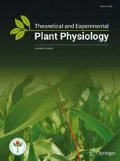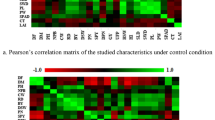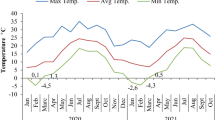Abstract
Vitis vinifera L. cv. Crimson Seedless is a late season red table grape developed in 1989, with a high market value and increasingly cultivated under protected environments to extend the availability of seedless table grapes into the late fall. The purpose of this work was to evaluate leaf water potential and sap flow as indicators of water stress in Crimson Seedless vines under standard and reduced irrigation strategy, consisting of 70 % of the standard irrigation depth. Additionally, two sub-treatments were applied, consisting of normal irrigation throughout the growing season and a short irrigation induced stress period between veraison and harvest. Leaf water potential measurements coherently signaled crop-available water variations caused by different irrigation treatments, suggesting that this plant-based method can be reliably used to identify water-stress conditions. The use of sap flow density data to establish a ratio based on a reference ‘well irrigated vine’ and less irrigated vines can potentially be used to signal differences in the transpiration rates, which may be suitable for improving irrigation management strategies while preventing undesirable levels of water stress. Although all four irrigation strategies resulted in the production of quality table grapes, significant differences (p ≤ 0.05) were found in both berry weight and sugar content between the standard irrigation and reduced irrigation treatments. Reduced irrigation increased slightly the average berry size as well as sugar content and technical maturity index. The 2-week irrigation stress period had a negative effect on these parameters.












Similar content being viewed by others
References
Allen RG, Pereira LS, Raes D, Smith M (1998) Crop evapotranspiration-Guidelines for computing crop water requirements-FAO Irrigation and drainage paper 56. FAO, Rome 300(9), D05109
Almanza PJ, Quljano-Rico MA, Fisher G, Chaves B, Balagueralopez HE (2010) Physicochemical characterization of ‘Pinot Noir’ grapevine (Vitis vinifera L.) fruit during its growth and development under high altitude tropical conditions. Agr Colomb 28:173–180
Baeza P, Sánchez-de-Miguel P, Centeno A, Junquera P, Linares R, Lissarrague JR (2007) Water relations between leaf water potential, photosynthesis and agronomic vine response as a tool for establishing thresholds in irrigation scheduling. Sci Hortic 114(3):151–158. doi:10.1016/j.scienta.2007.06.012
Braun P, Schmid J (1999) Sap flow measurements in grapevine (Vitis vinifera L.) 2. Granier measurements. Plant Soil 215:47–55
Carbonneau A (1995) General relationship within the whole-plant: examples of the influence of vigour status, crop load and canopy exposure on the sink "berry maturation" for the grapevine. Strateg Optim Wine Grape Qual 427:99–118
Cifre J, Bota J, Escalona J, Medrano H, Flexas J (2005) Physiological tools for irrigation scheduling in grapevine (Vitis vinifera L.) An open gate to improve water-use efficiency? Agric Ecosyst Environ 106:159–170
Cunha J, Teixeira-Santos M, Brazão J, Fevereiro P, Eiras-Dias JE (2013) Portuguese Vitis vinifera L. Germplasm: accessing its diversity and strategies for conservation. INTECH Open Access Publisher
Dokoozlian N, Luvisi D, Moriyama M, Schrader P (1995) Cultural practices improve color, size of ‘Crimson Seedless’. Calif Agric 49(2):36–40. doi:10.3733/ca.v049n02p36
Er-Raki S, Rodriguez JC, Garatuza-Payan J, Watts CJ, Chehbouni A (2013) Determination of crop evapotranspiration of table grapes in a semi-arid region of Northwest Mexico using multi-spectral vegetation index. Agric Water Manag 122:12–19
Faci JM, Blanco O, Medina ET, Martínez-Cob A (2014) Effect of post veraison regulated deficit irrigation in production and berry quality of Autumn Royal and Crimson table grape cultivars. Agric Water Manag 134:73–83
Fernández JE, Green SR, Caspari HW, Diaz-Espejo A, Cuevas MV (2008) The use of sap flow measurements for scheduling irrigation in olive, apple and Asian pear trees and in grapevines. Plant Soil 305(1–2):91–104
Giacosa S, Torchio F, Segade SR, Giust M, Tomasi D, Gerbi V, Rolle L (2014) Selection of a mechanical property for flesh firmness of table grapes in accordance with an OIV ampelographic descriptor. Am J Enol Viticult 65(2):206–214, ISSN 0002-9254
Ginestar C, Eastham J, Gray S, Iland P (1998) Use of sap-flow sensors to schedule vineyard irrigation. I. Effects of post-veraison water deficits on water relations, vine growth, and yield of Shiraz grapevines. Am J Enol Viticult 49(4):413–420
Gómez-del-Campo M, Baeza P, Ruiz C, Sotés V, Lissarrague JR (2007) Effect of previous water conditions on vine response to rewatering. VITIS-J Grapevine Res 46(2):51
Granier A (1985) Une neuvelle méthode pour la mesure du flux de sèvebrute dans le tronc des arbres. Ann des Sci For 42:193–200
Hsiao TC (1973) Plant responses to water stress. Annu Rev Plant Physiol 24:519–570
Jairmain C, Klaasse A, Bastiaanssen WGM, Roux AS (2007) Remote sensing tools for water use efficiency of grapes in the Winelands region. In Proceedings of the 13th Sanciahs Symposium, Sept (pp. 6–7)
Jones HG (2004) Irrigation scheduling: advantages and pitfalls of plant-based methods. J Exp Bot 55(407):2427–2436. doi:10.1093/jxb/erh213
Martínez de Toda F, Balda P, Oliveira M (2010) Evaluation of the vineyard water status (Vitis vinifera L. CV. Tempranillo) from the developmental stage of the shoot tips. J Int des Sci de la Vigne et du Vin 44(4):201–206
Mehmandoost N, Maskoki A, Hashemi N (2008) Determination of maturity index and harvesting time in various viticulture of grapevine. 18th national congress on food technology, Mashhad, 5–16 Oct 2008
Mencarelli F, Bellincontro A, DiRenzo G, Mejía D (2005) GRAPE: post-harvest operations. Food and Agriculture Organization (FAO) of the United Nations
Mendiburu F (2014) Agricolae: statistical procedures for agricultural research. R package version 1.2-1. http://CRAN.R-project.org/package=agricolae
Muñoz-Robredo P, Robledo P, Manríquez D, Molina R, Defilippi BG (2011) Characterization of sugars and organic acids in commercial varieties of table grapes. Chil J Agric Res 71(3):452–458
Nóbrega H (2013) Utilização de redes de ensombramento para monda de bagos em uva de mesa. Dissertação para obtenção do Grau de Mestre em Engenharia Agronómica. Instituto Superior de Agronomia, Lisboa
Novello V, De Palma L (2008) Growing grapes under cover. Acta Hortic 785(1):353–362
Poni S, Lakso AN, Turner JR, Melious RE (1993) The effects of pre-and post-veraison water stress on growth and physiology of potted Pinot Noir grapevines at varying crop levels. VITIS J Grapevine Res 32(4):207
Pou A, Medrano H, Tomàs M, Martorell S, Ribas-Carbó M, Flexas J (2012) Anisohydric behaviour in grapevines results in better performance under moderate water stress and recovery than isohydric behaviour. Plant Soil 359(1–2):335–349
R Core Team (2014) R: a language and environment for statistical computing. R Foundation for Statistical Computing. http://www.R-project.org/
Rana G, Katerji N, Introna M, Hammami A (2004) Microclimate and plant water relationship of the “overhead” table grape vineyard managed with three different covering techniques. Sci Hortic 102:105–120
Scholander PF, Hammel HJ, Bradstreet A, Hemmingsen EA (1965) Sappressure in vascular plants. Science 148:339–346
Schultz HR (2003) Differences in hydraulic architecture account for near-isohydric and anisohydric behaviour of two field-grown Vitis vinifera L. cultivars during drought. Plant Cell Environ 26(8):1393–1405
Shellie KC (2006) Vine and berry response of Merlot (Vitis vinifera L.) to differential water stress. Am J Enol Viticult 57(4):514–518
Silva-Contreras C, Selles-von Schouwen G, Ferreyra-espada R, Silva-robledo H (2012) Variation of water potential and trunk diameter answer as sensitivity to the water availability in table grapes. Chil J Agric Res 72(4):459–469, ISSN 0718-5839
Tardieu F, Simonneau T (1998) Variability among species of stomatal control under fluctuating soil water status and evaporative demand: modelling isohydric and anisohydric behaviours. J Exp Bot 49:419–432
Vandeleur RK, Mayo G, Shelden MC, Gilliham M, Kaiser BN, Tyerman SD (2009) The role of plasma membrane intrinsic protein aquaporins in water transport through roots: diurnal and drought stress responses reveal different strategies between isohydric and anisohydric cultivars of grapevine. Plant Physiol 149:445–460. doi:10.1104/pp.108.128645
Williams L, Baeza P (2007) Relations among ambient temperature and vapor pressure deficit and leaf and stem water potentials of fully irrigated, field-grown grapevines. Am J Enol Vitic 58:173–181
Williams L, Baeza P, Vaughn P (2012) Midday measurements of leaf water potential and stomatal conductance are highly correlated with daily water use of Thompson Seedless grapevines. Irrig Sci 30(3):201–212. doi:10.1007/s00271-011-0276-2
Acknowledgments
This research was funded by the project PRODER no. 46190 “MORECRIMSON—Técnicas de Produção e de Conservação de uvas sem grainha da variedade Crimson”. We thank the project-partner and grape producer Vale da Rosa and its staff for providing their facilities to host the study.
Author information
Authors and Affiliations
Corresponding author
Rights and permissions
About this article
Cite this article
Shahidian, S., Valverde, P., Coelho, R. et al. Leaf water potential and sap flow as indicators of water stress in Crimson ‘seedless’ grapevines under different irrigation strategies. Theor. Exp. Plant Physiol. 28, 221–239 (2016). https://doi.org/10.1007/s40626-016-0064-8
Received:
Accepted:
Published:
Issue Date:
DOI: https://doi.org/10.1007/s40626-016-0064-8




